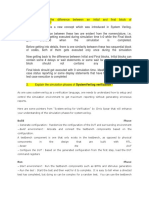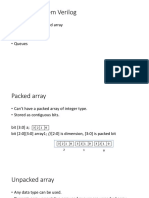0% found this document useful (0 votes)
5 views16 pagesm1 Verilog (Data Types)
The document discusses data types in Verilog, highlighting built-in types such as variables and nets, and introduces the logic type as an improvement over the classic reg type. It also covers two-state types, fixed-size arrays, packed and unpacked arrays, dynamic arrays, and queues, emphasizing their usage and advantages in simulation. Overall, it provides an overview of how these data types enhance performance and memory efficiency in design modeling.
Uploaded by
inchara27sCopyright
© © All Rights Reserved
We take content rights seriously. If you suspect this is your content, claim it here.
Available Formats
Download as PDF, TXT or read online on Scribd
0% found this document useful (0 votes)
5 views16 pagesm1 Verilog (Data Types)
The document discusses data types in Verilog, highlighting built-in types such as variables and nets, and introduces the logic type as an improvement over the classic reg type. It also covers two-state types, fixed-size arrays, packed and unpacked arrays, dynamic arrays, and queues, emphasizing their usage and advantages in simulation. Overall, it provides an overview of how these data types enhance performance and memory efficiency in design modeling.
Uploaded by
inchara27sCopyright
© © All Rights Reserved
We take content rights seriously. If you suspect this is your content, claim it here.
Available Formats
Download as PDF, TXT or read online on Scribd
/ 16























































